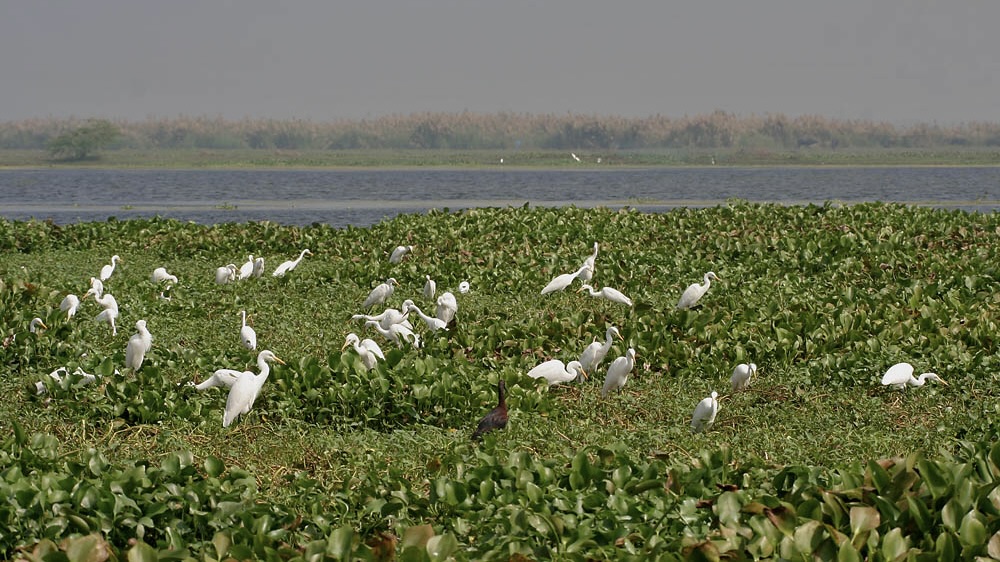The Telugu Desam Party-led government is seeking an equitable resolution to a longstanding dispute over regulatory restrictions surrounding Kolleru Lake, balancing ecological concerns with the welfare of farmers.
Published Jun 02, 2025 | 9:44 PM ⚊ Updated Jun 02, 2025 | 9:44 PM

Kolleru Lake Wildlife Sanctuary. (Wikimedia Commons)
Synopsis: The Andhra Pradesh government is renewing efforts to seek Supreme Court and Central Empowered Committee approval for excluding 20,000 acres of farmland from the Kolleru Wildlife Sanctuary to support local farmers’ livelihoods. Despite the lake’s ecological importance as a Ramsar site, sanctuary regulations have long restricted agricultural activity, which the state argues has caused hardship to nearly three lakh residents.
The Andhra Pradesh government is preparing to request the Central Empowered Committee (CEC) and the Supreme Court to exclude around 20,000 acres of land from the Kolleru Lake Wildlife Sanctuary limits, citing the need to protect the livelihoods of thousands of farmers in the region.
The Telugu Desam Party-led government is seeking an equitable resolution to a longstanding dispute over regulatory restrictions surrounding Kolleru Lake, balancing ecological concerns with the welfare of farmers.
Nestled between the Krishna and Godavari deltas in the Eluru district, Kolleru is one of India’s largest freshwater lakes and a critical wetland ecosystem.
Recognised for its ecological significance, it was declared a wildlife sanctuary in 1999 under the Wildlife Protection Act (1972) and later designated a Ramsar site in 2002.
The sanctuary spans 308 square kilometres at the +5 metre contour level. It supports over 220 bird species – including the spot-billed pelican, painted stork, and Siberian crane – and 63 species of fish. The lake also plays a critical role in flood control, carbon sequestration, and sustaining the livelihoods of local fishing and farming communities.
However, nearly three lakh people living around the lake have faced growing hardships due to sanctuary regulations that restrict farming and land use.
Chief Minister N Chandrababu Naidu, at a review meeting on Monday, 2 June, at the State Secretariat in Velagapudi, underscored the need to maintain the ecological health of the lake while ensuring justice for affected residents.
He called for treating drainage water entering the lake, desilting clogged channels, and removing encroachments on Upputeru – the outlet draining Kolleru into the sea – to prevent backflow and flooding.
Simultaneously, Naidu stressed the need to protect local interests.
“About 20,000 acres of Jirayat and D-Patta lands are caught in this contour dispute. Justice must be ensured for these farmers,” he said, directing officials to prepare a proposal for the CEC and Supreme Court.
“Any action plan must safeguard both the environment and the people.”
Jirayat lands refer to privately owned and revenue-assessed lands historically held by farmers, typically with fewer restrictions. D-Patta lands are government-assigned lands allocated to landless families as a means of livelihood support.
The issue dates back to 2014, when the Andhra Pradesh Legislative Assembly passed a resolution urging the National Board for Wildlife (NBWL) and the Supreme Court-appointed CEC to reduce the sanctuary boundary from the +5 metre contour (308 sq km) to the +3 metre contour (135 sq km).
In 2018, the NBWL recommended the exclusion of 20,000 acres – including 15,000 acres of Jirayat lands and 5,600 acres of D-Patta lands – from the sanctuary limits. The move was intended to ease restrictions on farming and fishing activities.
The TDP, then also at the helm of the government, endorsed the recommendation, aiming to address long-standing grievances among residents.
However, the proposal met with stiff resistance. In July 2018, the CEC rejected the NBWL’s recommendation, citing a 2006 Supreme Court order that prioritised the ecological integrity of the sanctuary. The committee advised further consultations before any decision could be made.
Government sources allege that the subsequent Yuvajana Sramika Rythu Congress Party government (2019–2024) did not make significant progress on the matter.
Now, with the TDP government back in power, the issue has returned to the forefront, as the state prepares to press its case before the CEC and the Supreme Court once again.
(Edited by Dese Gowda)
